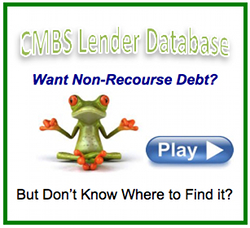How to Find Non-Recourse Debt
Warning: Use of undefined constant user_level - assumed 'user_level' (this will throw an Error in a future version of PHP) in /home/zzgspc5zic0z/domains/findthecapital.com/html/wp-content/plugins/ultimate-google-analytics/ultimate_ga.php on line 524
Gain Access to the World's First and Only Investor Database of the Most Active CMBS Lenders Focused 100% on Real Estate!
Just $97 (Limited to the First 1,000 Subsribers)
Dear Entrepreneur,
 I'm Lisa Virkus, Founder and CEO of Find the Capital.
I'm Lisa Virkus, Founder and CEO of Find the Capital.
We give entrepreneurs the tools and resources they need to grow their business. One of the most important areas we help our followers with is finding capital for their real estate projects.
With interest rates at historical lows and headed higher, there has never been a better time to refinance your existing debt or put new debt on your commercial real estate. When doing so the most important thing to do is make sure that debt is "non-recourse". In other words, does not require you to sign a personal guarantee.
Don't let one bad deal destroy your entire net worth like a lot of people did during the last economic downturn.
One of the best ways to find "non-recourse" debt is through the CMBS market. The issue? A lot of us have no idea how to find CMBS lenders. Furthermore, if you do know who a CMBS lender is, you have no idea how to contact them. So find the capital has done it for you. We've scoured the market for the most active CMBS lenders and have created the first and only Most Active CMBS Lender Database. Here are just a few of the most active CMBS lenders that hit the database:



The best thing about Find the Capital's Most Active CMBS Lender Database, is not only have we identified who the most active lenders are, but....
[red_tick_list width="100%"]- What size deals they will consider
- Types of real estate they will lend on
- Geographical locations they will consider
- Who to call within the organization to present your deal
- Their direct phone number
- Their direct email address
- Corporate website
Yes, we've done it all for you so you can easily and quickly figure out who is the best group for your deal and who to call! We invite you to take advantage of the first and only Most Active CMBS Lenders Database by clicking the Download button below:
Just $97 (Limited to the First 1,000 Subsribers)
[divider_bar]Insert Your Text Here[/divider_bar]Want to Know a Little More About CMBS Debt and How it Works? Let Use Walk You Through it!
What is a Conduit Loan (i.e. CMBS Loan)?
Commercial real estate first mortgage debt is generally broken down into two basic categories: (1) loans to be securitized (“CMBS loans”) and (2) portfolio loans. Portfolio loans are originated by a leader and held on its balance sheet through maturity. In a CMBS transaction, many single mortgage loans of varying size, property type and location are pooled and transferred to a trust. The trust issues a series of bonds that may vary in yield, duration and payment priority. Nationally recognized rating agencies then assign credit ratings to the various bond classes ranging from investment grade (AAA/Aaa through BBB-/Baa3) to below investment grade (BB+/Ba1 through B-/B3) and an unrated class which is subordinate to the lowest rated bond class.
Investors choose which CMBS bonds to purchase based on the level of credit risk/yield/duration that they seek. Each month the interest received from all of the pooled loans is paid to the investors, starting with those investors holding the highest rated bonds, until all accrued interest on those bonds is paid. Then interest is paid to the holders of the next highest rated bonds and so on. The same thing occurs with principal as payments are received. This sequential payment structure is generally referred to as the “waterfall.” If there is a shortfall in contractual loan payments from the Borrowers or if the loan collateral is liquidated and does not generate sufficient proceeds to meet payments in all bond classes, the investors in the most subordinate bond class will incur a loss with further losses impacting more senior classes in reverse order of priority.
The typical structure for the securitization of commercial real estate loans is a real estate mortgage investment conduit (REMIC). A REMIC is a creation of the tax law that allows the trust to be a pass-through entity which is not subject to tax at the trust level. The CMBS transaction is structured and priced based on the assumption that it will not be subject to tax with respect to activities; therefore, compliance with REMIC regulations is essential.
CMBS has become an attractive capital source for commercial mortgage lending because the bonds backed by a pool of loans are generally worth more than the sum of the value if the whole loans. The enhanced liquidity and structure of CMBS attracts a broader range of investors to the commercial mortgage market. This value creation effect allows loans intended for securitization to be aggressively priced, benefiting Borrowers.
THINGS TO BE CONSIDERED BEFORCE CLOSING A CONDUIT LOAN:
Many misconceptions about the CMBS lending still exist among Borrowers , mortgage bankers and brokers. Especially with respect to how loans are serviced once they have been securitized. While basic loan administration for CMBS loans is substantially the same as for portfolio loans, some key differences exist between servicing for CMBS versus portfolio loans. Borrowers should be informed of the rules governing CMBS servicing as well as the mechanics for processing servicing requests. Borrowers need to carefully consider what types of servicing requests they many have over the life of the loan and try to address how these requests will be handled in their loan documentation before the loan closes.
THE POOLING AND SERVICING AGREEMENT:
Once the loan is transferred to a trust and securitized, the loan is serviced in accordance with the applicable loan documents and the Pooling and Servicing Agreement (PSA) for the trust. The PSA governs the allocation and distribution of loan proceeds and losses to the bondholders. It also describes in detail how the loans are to be serviced and includes guidance to ensure that the trust continues to comply with the REMIC provisions of the tax code in order for the trust to maintain favorable tax treatment. A key difference between traditional portfolio loans and CMBS loans is that, while each portfolio lender will apply his own individualized standards, CMBS services administer loans in accordance with PSAs which generally standardize practices and procedures to meet REMIC requirements and to protect the bondholders. Examples of REMIC restrictions relative to CMBS loan servicing requests are provided in more detail later.
All CMBS servicers (primary, master and special) are required to act in accordance with the “servicing standard” as defined in the applicable PSA. Although the definitions may vary slightly from deal to deal, the same standard usually requires the servicer to use the same care, skill and diligence as it uses to service and administer comparable mortgage loans on behalf of third parties or on behalf of itself, whichever is the higher standard. Due consideration is given to customary and usual standards of practice utilized by institutional commercial mortgage lenders or servicers under comparable circumstances.
CMBS INDUSTRY PARTICPANTS:
PRIMARY OR SUB-SERVICER:
In some cases the Borrower may deal with a Primary Servicer that may also be the loan originator or Mortgage Banker who sourced the loan. The Primary Servicer maintains the direct Borrower contact, and the Master Servicer may sub-contract certain loan administration duties to the Primary or Sub-Servicer. The Master Servicer remains responsible to the trust for the Primary Servicer’s performance and actions. While Master Servicers maintains all of the responsibilities and duties to the trust under the PSA, a sub-servicing agreement between Master Servicer and Primary Servicer typically mirrors the servicing provisions under the PSA so that the Primary Servicer’s discretion is fairly limited and subject to the same servicing standard as the Master Servicer. Given their role in the origination of the loan, the originator or Mortgage Banker’s involvement as a Sub-Servicer allows for Borrower relationships to be maintained while adding to the collective servicing knowledge about the loan.
MASTER SERVICER:
The Master Servicer’s responsibility is to service the loans in the pool through maturity unless the Borrower defaults. The Master Servicer manages the flow of payment and the information and is responsible for the ongoing interaction with the performing Borrower. The Master Servicer is responsible for collecting the payments from the Borrower, holding and making any disbursements from escrows and performing most routine loan administration functions. The Master Servicer is also responsible for collection and analyzing rent rolls, operating statements and other financial and property information from the Borrower, as well as conducting periodic physical inspections. A Primary Servicer may perform many of these responsibilities to the extent a sub-servicing arrangement is in place.
The Master Servicer is generally required to process all Borrower requests related to consents, waivers, and modifications related to performing loans. The Master Servicer’s ability to waive, consent or modify terms of any mortgage loan is governed by the PSA. Many material servicing requests or modifications will also require the consent or approval of the Special Servicer. In some cases those decisions are further subject to approval by the Directing Certificateholder or review by Rating Agencies as described later.
SPECIAL SERVICER:
Upon the occurrence of certain specified events, primarily a default, the administration of the loan is transferred to the Special Servicer. A Borrower will receive notification from the Master or Special Servicer if its loan has been transferred to Special Servicing. Besides handling defaulted loans, the Special Servicer also has approval authority over material servicing actions, such as loan assumptions.
The Special Servicer is a specialist in dealing with defaulted mortgage loans and is usually selected by the Directing Certificateholder. In many cases the Special Servicer is a related entity to the Directing Certificateholder. Like Master Servicer, the Special Servicer has a duty to the trust and is subject to the serving standard. The standard usually mandates that the Special Server must act to maximize the recovery on the mortgage loan to the bondholders (as a collective whole) based on an analysis of collection alternatives using a net present value methodology. The Special Servicer will consider multiple alternatives as part of its analysis including loan modification, foreclosure, deed-in-lieu, negotiated payoff or sale of the defaulted loan. Frequently the Directing Certificateholder also has the ability to direct the Special Servicer’s actions with respect to defaulted loans. Provided the servicing standard is maintained.
DIRECTING CERTIFICATEHOLDER / CONTROLLING CLASS / B-PIECE BUYER:
The investor in the most subordinate bond classes is commonly referred to as the “B-Piece Buyer.” B-Piece Buyers generally purchase the B-Rated and BB/Ba-rated bond classes along with the unrated class. The most subordinate bond class outstanding at any given point is considered to be the Directing Certificatehilder, also referred to as the Controlling Class. Given that losses come out of the lowest rated bonds, the PSA provides the Directing Certificateholder the opportunity to play an active role in monitoring the performance of each loan, make decisions on key asset issues and appoint and/or terminate the Special Servicer.
TRUSTEE:
The Trustee’s primary role is to hold all the loan documents and distribute payments received from the Master Servicer to the bondholders. Although the Trustee is typically given broad authority with respect to certain aspects of the loan under the PSA, the Trustee typically delegates its authority to either the Special Servicer or the Master Servicer. As holder of the loans, the Trustee will be named in enforcement actions related to the loans (such as lawsuits or non-judicial foreclosure actions) yet in most instances the Trustee is acting by and through either the Master Servicer of the Special Servicer. All Borrower interaction rarely, if ever, interacts with the Trustee.
RATING AGENCY(IES):
There will be as few as one and as many as four Rating Agencies involved in rating a securitization. Rating agencies establish bond ratings for each bond class at the time the securitization is closed. They also monitor the pool’s performance and update ratings for investors based on performance, delinquency and potential loss events affecting the loans within the trust.
The bond ratings assigned at the time the securitization closes assume that the credit quality of the loan pool will not change significantly over time. As such, some decisions cannot be made without respect to the loans in a securitized pool without rating agency confirmation that such actions will not cause a downgrade of any of the bond class ratings. Rating Agency confirmation is frequently required with respect to actions on the largest loan in the trust, but certain items such as approval of subordinate financing may also require Rating Agency confirmation regardless if the size of the loan. The Rating Agencies will work directly with a servicer in processing these types of requests and will not interact directly with the Borrower.
CMBS SERVICING Who to Contact:
Borrowers should always initiate their requests with the Primary or Master Servicer, as they know who the players are in the securitization, what the process is, what information is needed for the specific request and whose consent is required. Even if the request must ultimately be approved by the Special Servicer or Directing Certificateholder, there parties will still generally look to the Primary or Master Servicer for a recommendation. It is common practice for servicers to send an introductory letter to the Borrower at the time a loan is closed or securitized, which typically includes a contact address. In the event such correspondence is not available, Borrowers should review their monthly billing statement to locate the identity of the Primary or Master Servicer for their loans and obtain contact information.
COMMON BORROWER REQUESTS:
Just as portfolio lenders service loans to protect their interests, CMBS servicers will act to protect the interests of the certificateholders as a whole. Unlike portfolio loans, where serving decisions are guided by the leaders’ own internal policies, CMBS servicers’ discretion in servicing loans is governed by the PSA and, in some instances, restricted by the REMIC regime.
Complying with REMIC regulations is central to most CMBS transactions to maintain the trust’s favorable tax treatment. One of the primary restrictions imposed upon the trust by the REMIC regime is the requirement that the loan constitute a “static pool.” This means that substitution of collateral cannot occur nor can the loan be materially modified unless specifically provided for in the loan documents or unless the loan has defaulted or default is deemed imminent. Many Borrowers offer good solutions to problems that are, however, not permissible under REMIC regulations and are frustrated when the CMBS servicer must reject their request. Even so, the requirements the REMIC tax regime has on CMBS servicing are limited and, in large measure, can be ameliorated by advanced planning. It is, consequently, extremely important at the loan origination stage to think through, in advance, the needs of the property over the life of the loan and what features and flexibility should be specifically spelled out in the loan documents at origination. This will help avoid a possible REMIC restriction and provide the servicer with clear direction as to how requests are to be handled.
PREPAYMENT AND DEFEASANCE:
CMBS bonds are generally called protected. Call protection is an attractive feature of CMBS to many bond investors and implies that the underlying CMBS loans cannot be prepaid without some form of compensating payment being made to enable investors to maintain their expected yield. Bond investors are willing to accept tighter yields on CMBS because of the call protection. This results in more aggressive pricing to Borrowers. Call protection in CMBS is achieved through either defeasance of some form of prepayment calculation.
The form of call protection unique to CMBS loans is defeasance. Defeasance is the substitution of government securities for the property of collateral. A Borrower desiring to obtain a release of its property from the trust may purchase and pledge to the trust a collection of government securities that are specifically selected to generate sufficient cash to make all monthly payments due on the loan through and including any balloon payment due on the maturity date. Defeasance is not prepayment. Technically the note remains outstanding, but is repaid from cash flow from the government securities purchased rather than through cash flow generated by a property. The property is released to the Borrower free from the mortgage lien. In an interest rate environment higher than the loan coupon, a Borrower may even be able to defease for legal, accounting and rating agency fees. Defeasance is prohibited for at least the first two years following securitization due to REMIC prohibitions on substitution of collateral.
Prepayments differ from defeasance in that the note is actually paid off and removed from the trust. Prepayments are frequently accompanied by the payment of a sum of money designed to compensate investors for the loss of yield. This is often referred to as yield maintenance. Yield maintenance is a present value calculation that enables investors to reinvest the loan payoff proceeds at then current treasury yields through the original loan maturity and maintain the same yield as if the loan had not paid off early. Yield maintenance should not be viewed as a “windfall” to the trust as it only allows investors to maintain their expected yield bond classes. The amount of yield maintenance at any point in time depends on the level of current treasury yields relative to the loan coupon. The lower treasury rates are relative to the loan coupon, the greater yield maintenance amount. Prepayments at par are frequently allowed in many CMBS loans near the end of the loan term, commonly the last 3-6 months. More flexible prepayment terms are, however, available on floating rate CMBS than on fixed rate CMBS.
Each Borrower should carefully consider whether prepayment of defeasance is its right course of action, especially considering the potential fees involved. In certain higher interest rate environments, defeasance may provide a less expensive option for the Borrower to release the property from the trust. The out-of-pocket costs associated with defeasance, however, may make defeasance a more costly alternative for smaller loans or in a stable to lower interest rate environment.
[divider_bar]Insert Your Text Here[/divider_bar]Now that you know just about everything there is to know about CMBS Debt, we welcome you to Take Advantage of this great offer by simply click the download button below.
You will instantly be taken to Plimus, the industries leading internet market place, to process your order safely and accurately.
Once your order is complete you will be directed to a link that will immediately download our…
Most Active CMBS Lender Database
Make sure to take advantage of this one time offer… Once the 1,000 copies are sold we are required to raise our prices.
So gain Immediate Access to…
Something that will truly take your business to the next level!
Simply click the download button below and find the capital you need!
Just $97 (Limited to the first 1,000 subscribers.)
[divider_bar]Insert Your Text Here[/divider_bar]
Visit www.findthecapital.com to learn more about our resources!
Please feel free to email us at info@findthecapital.com with any questions.













